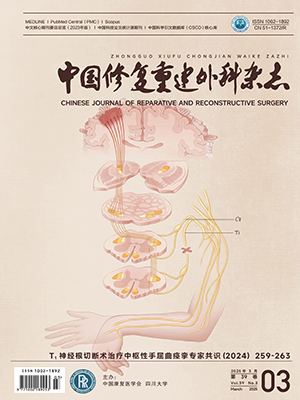Objective Ginsenoside Rg1 could increase the tolerance of neural hypoxia and ischemia under stress, and play an anti-apoptotic effect in hypoxia ischemia brain damage (HIBD). To investigate the effects of ginsenoside Rg1 on neural apoptosis and recovery of neurological function in neonatal rats with HIBD, and to explore the possible mechanism. Methods Fifty-four 10-day-old SD rats (weighing 16-22 g) were randomly allocated into sham-operation group (Sham group, n=6), HIBD model group (HIBD group, n=24), and ginsenoside Rg1 treatment group (Rg1 group, n=24). SD
rats in HIBD group and Rg1 group were made the models of HIBD by l igation of the right common carotid artery (CCA) and subsequently hypoxic ventilation (8%O2 plus 92%N2) for 2.5 hours; and in Sham group, the right CCA was only exposed without l igation of CCA and hypoxic ventilation. Intraperitoneal injection of 0.1 mL normal sal ine (NS) containing 40 mg/kg Rg1 was given immediately after operation in Rg1 group, intraperitoneal injection of 0.1 mL pure NS was given in both HIBD group and Sham group and was repeated every 24 hours. The general state of SD rats was monitored after operation, and Longa scores were recorded to evaluate the neurological function at 4, 8, 24, and 72 hours after HIBD. Western blot and immunohistochemistry staining were used to detect protein expressions of both hypoxia inducible factor 1α (HIF-1α) and cleaved caspase 3 (CC3). TUNEL staining was used to evaluate neural apoptosis in situ. Results All rats survived to the end of the experiment. Neurological dysfunction was observed in both HIBD group and Rg1 group, showing significant difference in Longa score when compared with that in Sham group (P lt; 0.05). There was significant difference in Longa score between Rg1 group and HIBD group at 72 hours after HIBD (P lt; 0.05). Western blot showed that the protein expressions of both HIF-1α and CC3 were observed at every time point in every group. The expressions of HIF-1α protein in HIBD group and Rg1 group were significantly higher than those in Sham group at 4, 8, 24, and 72 hours (P lt; 0.05), and the expressions in Rg1 group were significantly higher than those in HIBD group (P lt; 0.05). The expressions of CC3 protein in HIBD group were significantly higher than those in Sham group at 4, 8, 24, and 72 hours (P lt; 0.05), and significant difference was found between Rg1 group and Sham group only at 4 hours (P lt; 0.05). Immunohistochemistry staining demonstrated that HIF-1α and CC3 protein mainly distributed in nucleus
and cytoplasma, the results of HIF-1α and CC3 protein expression were similar to the results by Western blot. TUNEL staining showed that the positive cells were characterized by yellow or brown particle confined within nucleus. The number of apoptotic cells at every time point in HIBD group was significantly higher when compared with that in Sham group (P lt; 0.05), and the number of apoptotic cells in Rg1 group was significantly lower when compared with that in HIBD group at 8, 24, and 72 hours (P lt; 0.05). Conclusion Rg1 could inhibit Caspase 3 activation by strengthening and stabil izing HIF-1α signal pathway, and plays a role of anti-apoptosis in neonatal rats with HIBD.
Citation: WANG Dejian,HUANG Yuanfang,LI Qiaoyun,XU Shijun,LIU Xiaokang. ANTI-APOPTOTIC EFFECT OF GINSENOSIDE Rg1 ON NEURON AFTER NEONATAL HYPOXIA ISCHEMIA BRAIN DAMAGE. Chinese Journal of Reparative and Reconstructive Surgery, 2010, 24(9): 1107-1112. doi: Copy
Copyright © the editorial department of Chinese Journal of Reparative and Reconstructive Surgery of West China Medical Publisher. All rights reserved




